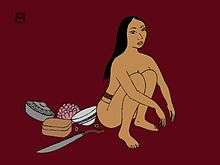Dema Deity
Dema Deity is a concept introduced by Adolf Ellegard Jensen following his research on religious sacrifice.[1] Jensen was a German ethnologist who furthered the theory of Cultural Morphology founded by Leo Frobenius.[2]

Description
The term dema comes from the Marind-anim peoples of south-west Papua and has been used to refer to similar concepts in Melanesian Religion and elsewhere.[3]
Dema Deities are mythological figures (human, animal, or super-human) who have given to certain peoples their land, food-crops, totems, and knowledge such as how to cultivate crops, raise poultry, make boats, perform dances, and perform sacred rituals. In some cases, such as in the Hainuwele myth of Seram recorded by Jensen, it is claimed that from their dismembered bodies, blood, etc., came the different communities that are now in existence, together with their territory.[3]
Both local culture and natural environment remain infused with the supernatural power of these creative deities.[3]
Examples
- Coyolxāuhqui, from Aztec mythology
- Cronus, from Greek Mythology
- Osiris, from Egyptian religion
- Pangu, from Chinese Mythology
- Uke Mochi, from Shinto religion
- Tiamat, from Babylonian Mythology
- Ymir, from Norse Mythology
See also
- Myth of origins
- Religious experience
- Uke Mochi
References
- Jensen, Adolf Ellegard (1963). Myth and Cult among Primitive Peoples. University of Chicago Press.
- Stausberg, Michael. "The study of religion(s) in Western Europe II" (PDF).
- Habel, N.C., ed. (1979). Powers, Plumes and Piglets: Phenomena of Melanesian religion. Bedford Park, South Australia: Australia Association for the Study of Religions. ISBN 0-908083-07-6.
Further reading
- Fortune, R.F. (1979) [1963; 1932]. Sorcerers of Dobu: The social anthropology of the Dobu Islanders of the Western Pacific (reprint ed.). London, UK; Darby, PA: Routledge & Kegan Paul; Arden. ASIN B000MX07MG.
- Williams, F.E. (1940). Drama of Orokolo: The social and ceremonial life of the Elema. Oxford, UK: Clarendon Press. "NLA 908917".
- Strehlow, T.G.H. (1971). "Australia". In Bleeker, C.J.; Widengren, G. (eds.). Historia Religionum: Handbook for the history of religions. 2. Leiden: Brill. pp. 609–628. ISBN 9788470571435 – via Google Books.
- Seligman, C.G. (1976) [1910]. The Melanesians of British New Guinea (repr. ed.). Cambridge, UK; New York, NY: Cambridge University Press; AMS. ISBN 0-404-14174-9.
- Best, E. (1976) [1924]. Maori Religion and Mythology. Dominion Museum Bulletin. 10 (reprint ed.). Wellington, NZ; New York, NY: Government Printer; AMS. ISBN 0-404-14412-8.
- Burridge, K. (1969). Tangu Traditions: A study of the way of life, mythology, and developing experience of a New Guinea people. Oxford, UK: Clarendon Press. ISBN 0-19-823136-9.
- Eliade, M. (1973). Australian Religions: An introduction. London, UK; Ithaca, NY;: Cornell University Press. ISBN 0-8014-0729-X.CS1 maint: extra punctuation (link)
- Elkin, A.P. (1978) [1977]. Aboriginal Men of High Degree (2nd ed.). St. Lucia, AU; New York, NY: University of Queensland Press; St. Martin's Press. ISBN 0-7022-1017-X.
- Geertz, C. (1976) [1960]. The Religion of Java. Glencoe, IL; Chicago, IL: Free Press; University of Chicago Press. ISBN 0-226-28510-3.
- Jensen, E. (1975) [1974]. The Iban and their Religion. Oxford, UK: Clarendon Press. ISBN 0-19-823179-2.
- Pognant, R. (1967). Oceanic Mythology: The myths of Polynesia, Micronesia, Melanesia, Australia. London: Hamlyn. ISBN 0-600-02372-9.
External links
- Sorcerers of Dobu: The social anthropology of the Dobu Islanders of the Western Pacific. Waveland Press. August 1989. ISBN 0-88133-452-9.
- "Williams, Francis. Edgar".
- "Drama of Orokolo: The social and ceremonial life of the Elema". Archived from the original on 2011-03-01.
- "A book review of Drama of Okokolo: The Social and Ceremonial Life of the Elema by F.E. Williams". The Geographical Journal. 96 (1): i–viii. 1940. ISSN 0016-7398. JSTOR 1788493.
- "Orokolo".
- "Orokolo - Bibliography".
- Bleeker, C.J.; Widengren, G. (1988). Historia Religionum: Handbook for the History of Religions. ISBN 90-04-08928-4.
- "The Melanesians of British New Guinea".
- "Elsdon Best: Maori Religion and Mythology – Part 1".
- "Bibliography - Burridge Kenelm".
- Jorgensen, Dan (1994). "Locating the Divine in Melanesia: An Appreciation of the Work of Kenelm Burridge". Anthropology and Humanism. 19 (2): 130–137. doi:10.1525/ahu.1994.19.2.130.
- Robbins, Sterling (1970). "General and Ethnology: Tangu Traditions: A Study of the Way of Life, Mythology, and Developing Experience of a New Guinea People. Kenelm Burridge". American Anthropologist. 72 (6): 1530–1532. doi:10.1525/aa.1970.72.6.02a00790.
- Eliade, Mircea (1966). Australian Religions: An Introduction. ISBN 080140729X.
- The Iban and Their Religion. ASIN 0198231792.
- Oceanic Mythology: The Myths of Polynesia, Micronesia, Melanesia, Australia. ISBN 0814803865.
- "Bibliography - Roslyn Poignant".